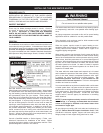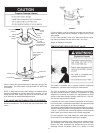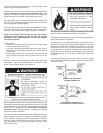
9
REQUIRED ABILITY
INSTALLATION OR SERVICE OF THIS WATER HEATER
REQUIRES ABILITY EQUIVALENT TO THAT OF A LICENSED
TRADESMAN IN THE FIELD INVOLVED. PLUMBING, AIR
SUPPLY, VENTING AND GAS SUPPLY ARE REQUIRED.
INSPECT SHIPMENT
There may be hidden damage caused in transit. Check to
be certain all parts of the venting system, as listed below,
are present. CAUTION!!! IF THERE ARE ANY DAMAGED
PARTS, DO NOT INSTALL THIS WATER HEATER. REPORT
ANY SHORTAGE TO YOUR DISTRIBUTOR OR DAMAGE TO
YOUR CARRIER.
GENERAL
The installation must conform to these instructions and the local
code authority having jurisdiction. In the absence of local codes,
the installation must comply with the current editions of the “Nat-
ural Gas and Propane Installation Code” CAN/CSA-B149.1.
The code is available from the Canadian Standards Association,
5060 Spectrum Way, Mississauga, Ontario, Canada, L4W 5N6.
WATER PIPING
HOTTER WATER CAN SCALD:
Water heaters are intended to produce hot water. Water heated
to a temperature which will satisfy space heating, clothes wash-
ing, dish washing, cleaning and other sanitizing needs can scald
and permanently injure you upon contact. Some people are
more likely to be permanently injured by hot water than others.
These include the elderly, children, the infi rm, or physically/men-
tally handicapped. If anyone using hot water in your home fi ts
into one of these groups or if there is a local code or state law
requiring a certain temperature water at the hot water tap, then
you must take special precautions. In addition to using the low-
est possible temperature setting that satisfi es your hot water
needs, a means such as a *mixing valve, should be used at the
hot water taps used by these people or at the water heater, see
Figure 2. Valves for reducing point of use temperature by mixing
cold and hot water are also available:
Consult a Qualifi ed Installer or Service Agency. Follow man-
ufacturer’s instructions for installation of the valves. Before
changing the factory setting on the thermostat, read the “Tem-
perature Regulation” section in this manual.
This water heater shall not be connected to any heating systems
or component(s) used with a non-potable water heating appli-
ance.
All piping components connected to this unit for space heating
applications shall be suitable for use with potable water.
Toxic chemicals, such as those used for boiler treatment shall
not be introduced into this system.
When the system requires water for space heating at tem-
peratures higher than required for domestic water purposes, a
*mixing valve must be installed. Please refer to Figure 2 for
suggested piping arrangement.
Water supply systems may, because of such events as high line
pressure, frequent cut-offs, the effects of water hammer among
others, have installed devices such as pressure reducing valves,
check valves, back fl ow preventers, etc. to control these types of
problems. When these devices are not equipped with an internal
by-pass, and no other measures are taken, the devices cause
the water system to be closed. As water is heated, it expands
(thermal expansion) and closed systems do not allow for the
expansion of heated water.
The water within the water heater tank expands as it is heated
and increases the pressure of the water system. If the relieving
point of the water heater’s temperature-pressure relief valve
is reached, the valve will relieve the excess pressure. The
temperature-pressure relief valve is not intended for the
constant relief of thermal expansion. This is an unacceptable
condition and must be corrected.
It is recommended that any devices installed which could create
a closed system have a by-pass and/or the system have an ex-
pansion tank to relieve the pressure built by thermal expansion
in the water system. Expansion tanks are available for ordering
through a local plumbing contractor. Contact the local water
supplier and/or a service agency for assistance in controlling
these situations.
NOTE: To protect against untimely corrosion of hot and cold
water fi ttings, it is strongly recommended that di-electric
unions or couplings be installed on this water heater when
connected to copper pipe.
All gas piping must comply with local codes and ordinances or
with the “Natural Gas and Propane Installation Code” CAN/
CSA-B149.1 whichever applies. Copper and brass tubing and
fi ttings (except tin lined copper tubing) shall not be used.
INSTALLING THE NEW WATER HEATER


















